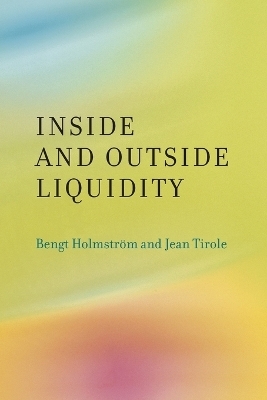
Inside and Outside Liquidity
Seiten
2013
MIT Press (Verlag)
978-0-262-51853-6 (ISBN)
MIT Press (Verlag)
978-0-262-51853-6 (ISBN)
- Lieferbar
- Versandkostenfrei
- Auch auf Rechnung
- Artikel merken
Two leading economists develop a theory explaining the demand for and supply of liquid assets.
Why do financial institutions, industrial companies, and households hold low-yielding money balances, Treasury bills, and other liquid assets? When and to what extent can the state and international financial markets make up for a shortage of liquid assets, allowing agents to save and share risk more effectively? These questions are at the center of all financial crises, including the current global one.
In Inside and Outside Liquidity, leading economists Bengt Holmstroem and Jean Tirole offer an original, unified perspective on these questions. In a slight, but important, departure from the standard theory of finance, they show how imperfect pledgeability of corporate income leads to a demand for as well as a shortage of liquidity with interesting implications for the pricing of assets, investment decisions, and liquidity management. The government has an active role to play in improving risk-sharing between consumers with limited commitment power and firms dealing with the high costs of potential liquidity shortages. In this perspective, private risk-sharing is always imperfect and may lead to financial crises that can be alleviated through government interventions.
Why do financial institutions, industrial companies, and households hold low-yielding money balances, Treasury bills, and other liquid assets? When and to what extent can the state and international financial markets make up for a shortage of liquid assets, allowing agents to save and share risk more effectively? These questions are at the center of all financial crises, including the current global one.
In Inside and Outside Liquidity, leading economists Bengt Holmstroem and Jean Tirole offer an original, unified perspective on these questions. In a slight, but important, departure from the standard theory of finance, they show how imperfect pledgeability of corporate income leads to a demand for as well as a shortage of liquidity with interesting implications for the pricing of assets, investment decisions, and liquidity management. The government has an active role to play in improving risk-sharing between consumers with limited commitment power and firms dealing with the high costs of potential liquidity shortages. In this perspective, private risk-sharing is always imperfect and may lead to financial crises that can be alleviated through government interventions.
Bengt Holmstroem is Paul A. Samuelson Professor of Economics at MIT, where he was Head of the Economics Department from 2003 to 2006. Jean Tirole, the 2014 Nobel Laureate in Economics, is Scientific Director of IDEI (Institut d'Economie Industrielle), Chairman of the Board of TSE (Toulouse School of Economics), and Annual Visiting Professor of Economics at MIT.
| Reihe/Serie | The MIT Press |
|---|---|
| Zusatzinfo | 22 figures; 22 Illustrations |
| Sprache | englisch |
| Maße | 152 x 229 mm |
| Gewicht | 363 g |
| Einbandart | kartoniert |
| Themenwelt | Betriebswirtschaft / Management ► Spezielle Betriebswirtschaftslehre ► Bankbetriebslehre |
| ISBN-10 | 0-262-51853-8 / 0262518538 |
| ISBN-13 | 978-0-262-51853-6 / 9780262518536 |
| Zustand | Neuware |
| Haben Sie eine Frage zum Produkt? |
Mehr entdecken
aus dem Bereich
aus dem Bereich
Buch | Hardcover (2012)
Westermann Schulbuchverlag
CHF 44,90
Schulbuch Klassen 7/8 (G9)
Buch | Hardcover (2015)
Klett (Verlag)
CHF 29,90
Buch | Softcover (2004)
Cornelsen Verlag
CHF 23,90


